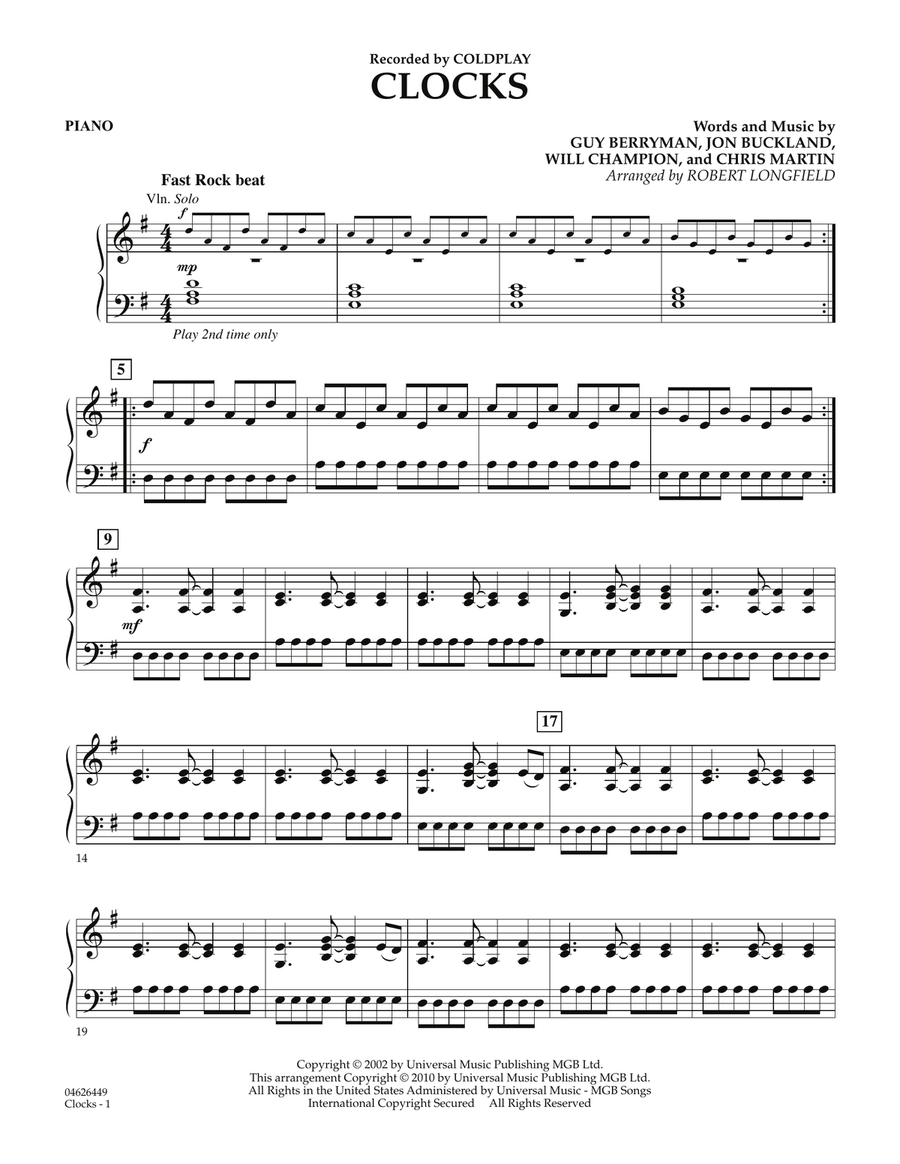Are you a Coldplay fan longing to master the iconic melody of “Clocks” on the piano? Look no further, as we delve into the intricacies of playing this timeless hit like a seasoned pro. “Clocks” by Coldplay is known for its catchy piano riff and distinctive sound that resonates with music enthusiasts worldwide. In this blog, we will guide you through the steps, chord progressions, and techniques required to recreate the magical notes of this chart-topping song. Whether you are a beginner seeking to enhance your skills or an experienced player aiming to nail every nuance of the melody, this comprehensive guide will equip you with the knowledge needed to play ‘Clocks’ with finesse.
Introduction: Discovering the Magic of “Clocks” by Coldplay
When it comes to iconic melodies in the realm of alternative rock, “Clocks” by Coldplay stands out as a timeless classic that has captivated music lovers worldwide. Released in 2002, this track continues to resonate with audiences, making it a must-learn piece for aspiring musicians and seasoned players alike. The distinctive piano riff, haunting lyrics, and Chris Martin’s soulful vocals all contribute to the allure of this song, making it a prime choice for those looking to master a memorable and evocative tune.
The Significance of “Clocks” in Coldplay’s Discography
Clocks by Coldplay marked a pivotal moment in Coldplay’s career, propelling them to global fame and solidifying their reputation as one of the most influential bands of the early 2000s. The song’s innovative blend of rock, pop, and electronic elements showcased the band’s musical versatility and set them apart from their contemporaries.
Breaking Down the Piano Arrangement
For those eager to learn how to play “Clocks” by Coldplay, mastering the intricate piano arrangement is essential. The song’s main hook, characterized by its rhythmic chord progression and cascading melodies, challenges musicians to hone their playing skills and sense of timing.
One key aspect that sets “Clocks” apart is its use of syncopation, a technique that adds a sense of urgency and drive to the music. By understanding and implementing these rhythmic nuances, players can truly capture the essence of the song.

Understanding the Chords: Breaking Down the Harmonies
Mastering the iconic melody of “Clocks” by Coldplay involves a deep understanding of the underlying chords and harmonies. Whether you’re a beginner or an experienced musician, dissecting the harmonies can enhance your playing and appreciation of this timeless piece.
The Main Chords
When learning how to play “Clocks” by Coldplay, focus on the main chords that drive the song. The progression includes Em7, G/B, D/A, and Csus2, creating a dynamic and captivating sound.
Pro tip:
Practice transitioning smoothly between these chords to capture the essence of the melody.
Chord Inversions
Exploring chord inversions can add depth to your rendition of “Clocks.” By inverting the chords, you can create a richer sound and unique interpretations of the song.
- Experiment with different inversions to find combinations that resonate with you.
- Use inversions strategically to infuse your personal touch into the performance.
Mastering the Rhythm: Unraveling the Intricate Beat
Mastering the rhythm of “Clocks” by Coldplay is key to playing it like a pro. Understanding the intricate beat that drives the song is essential for capturing its essence.
The Importance of Timing
Timing is crucial when playing “Clocks” as it sets the pace and mood of the song. Practice keeping a steady rhythm to stay in sync with the music.
Remember, rhythm is the heartbeat of the song that gives it life and energy.
Breaking Down the Beat
Start by listening carefully to the song and identifying the underlying beat. Use a metronome to practice playing along and internalizing the rhythm.
- Focus on the syncopated beats to capture the unique feel of “Clocks”.
- Pay attention to the subtle nuances in the rhythmic patterns for a more authentic rendition.
Playing the Melody: Techniques for Nailing the Iconic Tune
Learning how to play “Clocks” by Coldplay can be a challenging but rewarding experience for any aspiring musician. To truly master the melody of this iconic tune, it’s essential to focus on the following techniques:
Mastering the Chord Progression
Begin by familiarizing yourself with the chord progression of the song. The key chords in “Clocks” are C, G, Am, and F. Practice transitioning smoothly between these chords to capture the essence of the melody.
Perfecting the Rhythmic Pattern
Pay close attention to the rhythmic pattern of the song, characterized by its distinctive piano arpeggios. Emphasize the syncopated beats to create the driving force behind the melody.
Embracing Dynamic Contrast
Explore the dynamic range of “Clocks” by experimenting with volume fluctuations. Transition between soft, gentle passages and bold, dramatic crescendos to bring the melody to life.
Adding Flair: Embracing Variations and Improvisation
When learning how to play “Clocks” by Coldplay, it’s essential to add your own flair through variations and improvisation. Embracing these elements can elevate your performance and make it unique.
Experiment with Rhythmic Patterns
Try experimenting with different rhythmic patterns to add freshness to the melody. Consider playing around with syncopation or adding subtle pauses to create intrigue.
Explore Chord Inversions
Delve into chord inversions to give a new perspective to the song. By rearranging the order of the notes within the chords, you can create a more dynamic and interesting sound.
Additionally, consider incorporating arpeggios or broken chord patterns for a more intricate and captivating performance.
Practice Makes Perfect: Developing Your Skills Over Time
When it comes to mastering a complex melody like “Clocks” by Coldplay, consistent practice is key. Devoting time and effort to regular practice sessions can significantly improve your skills over time.
The Importance of Daily Practice
Set aside dedicated time each day to practice playing “Clocks.” Consistent daily practice will help you build muscle memory and strengthen your finger coordination.
Break It Down into Sections
Divide the song into smaller sections and focus on mastering each part individually before putting it all together. This approach can help you tackle challenging passages more effectively.
- Intro section
- Verse section
- Chorus section
- Bridge section
- Outro section
Frequently Asked Questions
- What is the song ‘Clocks’ by Coldplay known for?
- ‘Clocks’ by Coldplay is known for its catchy piano melody and distinctive rhythm.
- Is ‘Clocks’ by Coldplay a difficult song to play on the piano?
- While ‘Clocks’ by Coldplay has its challenges, with practice and dedication, it can be mastered by piano players of various skill levels.
- Are there any specific techniques required to play ‘Clocks’ like a pro?
- To play ‘Clocks’ by Coldplay like a pro, it’s important to focus on mastering the timing, dynamics, and precise finger placement on the piano keys.
- Are there any resources available to help learn how to play ‘Clocks’ by Coldplay?
- Yes, there are tutorials, sheet music, and online lessons available that can assist in learning how to play ‘Clocks’ by Coldplay on the piano.
- What makes ‘Clocks’ by Coldplay a popular choice among piano enthusiasts?
- ‘Clocks’ by Coldplay is popular among piano enthusiasts due to its melodic complexity, rhythmic intricacies, and emotional depth that resonates with listeners.
Mastering the Melody: How to Play ‘Clocks’ by Coldplay Like a Pro
In Summary, mastering how to play ‘Clocks’ by Coldplay requires patience, practice, and attention to detail. By breaking down the melody into manageable sections, understanding the chords and rhythm, and practicing with dedication, you can elevate your piano skills to a professional level. Remember to focus on dynamics, expression, and capturing the essence of the song’s emotion. Utilize resources like tutorials, sheet music, and online lessons to enhance your learning experience. Embrace the journey of mastering this iconic piece and enjoy the process of delving into Coldplay’s musical world. Let the music guide you, and soon you’ll be playing ‘Clocks’ with confidence and flair like a true pro.




